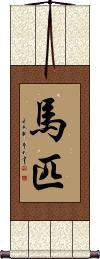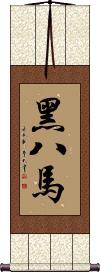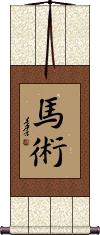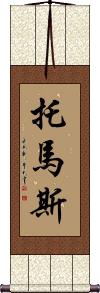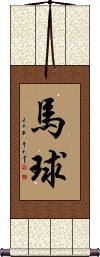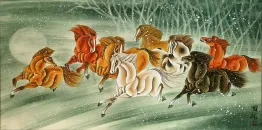Many custom options...
And formats...

5 Horses in Chinese / Japanese...
Buy a 5 Horses calligraphy wall scroll here!
Personalize your custom “5 Horses” project by clicking the button next to your favorite “5 Horses” title below...
Les Chevaux / Horses
Eight Black Horses
Bajutsu
Thomas
(Version 2)
This is a second common transliteration to Mandarin Chinese for the name Thomas.
There are two common ways to transliterate this name into Chinese. Both sound reasonably close to the English pronunciation of Thomas, so just pick the one that looks best to you. If you like horses, pick this one, as the second character means horse.
Polo
馬球 is the Chinese title for the ancient game of polo.
During the Tang Dynasty (618-907 AD), the elite and rich would mount their horses and engage in this rigorous sport. It was the only sport of that period that women were also known to play.
The original polo came from Persia and may have been played in China hundreds of years before the Tang popularized it.
The characters “馬球” literally mean “horse ball.”
This in-stock artwork might be what you are looking for, and ships right away...
Gallery Price: $178.00
Your Price: $98.88
Gallery Price: $178.00
Your Price: $98.88
Not the results for 5 horses that you were looking for?
Below are some entries from our dictionary that may match your 5 horses search...
| Characters If shown, 2nd row is Simp. Chinese |
Pronunciation Romanization |
Simple Dictionary Definition |
月 see styles |
yuè yue4 yüeh tsuki つき |
More info & calligraphy: Moon(1) Moon; (2) month; (3) moonlight; (4) (See 衛星・1) (a) moon; natural satellite; (female given name) Runa candra, 旅達 (旅達羅); 旂陀羅; 戰達羅; 戰捺羅 the moon, called also 蘇摩 soma, from the fermented juice of asclepias acida used in worship, and later personified in association with the moon. It has many other epithets, e. g. 印度 Indu, incorrectly intp. as marked like a hare; 創夜神 Niśākara, maker of the night; 星宿王 Nakṣatranātha, lord of constellations; 喜懷之頭飾 the crest of Siva; 蓮華王 Kumuda-pati, lotus lord; 白馬主 Śvetavājin, drawn by (or lord of) white horses; 大白光神 Śītāṃśu, the spirit with white rays; 冷光神 Sitamarici, the spirit with cool rays; 鹿形神 Mṛgāṅka, the spirit with marks m form like a deer; 野兎形神 Śaśi, ditto like a hare. |
古馬 see styles |
koba こば |
More info & calligraphy: Guma |
馬匹 马匹 see styles |
mǎ pǐ ma3 pi3 ma p`i ma pi bahitsu ばひつ |
More info & calligraphy: Les Chevaux / Horseshorses |
円 see styles |
yuán yuan2 yüan meguru めぐる |
yen (Japanese currency); Japanese variant of 圓|圆 (1) circle; (n,n-pref) (2) entirety; whole; full; complete; (3) (slang) money; dough; moola; (4) enclosure inside a castle's walls; (5) (ksb:) soft-shelled turtle; (suffix) (6) suffix for ship names; suffix for names of people (esp. infants); suffix for names of swords, armour, musical instruments, etc.; suffix for names of dogs, horses, etc.; (1) yen; Japanese monetary unit; (2) circle; (female given name) Meguru |
匹 see styles |
pǐ pi3 p`i pi hiki ひき |
(bound form) matching; comparable to; (bound form) alone; single; one of a pair; classifier for horses, mules etc (Taiwan pr. [pi1]); classifier for cloth: bolt; horsepower (counter) (1) counter for small animals; (2) counter for rolls of cloth (two han in size); (3) roll of cloth; (counter) (1) counter for rolls of cloth (two han in size); (2) (archaism) counter for horses; (3) roll of cloth; (surname) Hiki |
噠 哒 see styles |
dā da1 ta |
(phonetic); command to a horse; clatter (of horses' hoofs) |
栃 see styles |
lì li4 li tochisaki とちさき |
archaic variant of 櫪|枥, oak; type of tree in ancient books; stable (for horses) (kana only) Japanese horse chestnut (Aesculus turbinata); (surname) Tochisaki |
櫪 枥 see styles |
lì li4 li kunogi くのぎ kunugi くぬぎ |
type of oak; stable (for horses) (kana only) sawtooth oak (Quercus acutissima) |
疋 匹 see styles |
yǎ ya3 ya hiki ひき |
variant of 雅[ya3] (counter) (1) counter for small animals; (2) counter for rolls of cloth (two han in size); (3) roll of cloth; (counter) (1) counter for rolls of cloth (two han in size); (2) (archaism) counter for horses; (3) roll of cloth; (surname) Hiki |
複 复 see styles |
fù fu4 fu fuku ふく |
to repeat; to double; to overlap; complex (not simple); compound; composite; double; diplo-; duplicate; overlapping; to duplicate (prefix) (1) compound; composite; multiple; re-; bi-; (2) (abbreviation) (See 複試合) doubles (tennis, badminton, etc.); (3) (abbreviation) (See 複勝式) place bet (in horse racing, etc.); show bet; bet that predicts a top 2 or top 3 finish (depending on number of horses, etc. in race) Double garments, wadded, lined; double; repeated. |
軏 𫐄 see styles |
yuè yue4 yüeh |
crossbar for yoking horses |
駟 驷 see styles |
sì si4 ssu shi し |
team of 4 horses four-horse carriage; team of four horses |
駢 骈 see styles |
pián pian2 p`ien pien |
(of a pair of horses) to pull side by side; to be side by side; to be fused together; parallel (literary style) |
駾 see styles |
tuì tui4 t`ui tui |
approach at swift gallop (on horses) |
騎 骑 see styles |
qí qi2 ch`i chi ki き |
to sit astride; to ride (a horse, bike etc); classifier for saddle horses (counter) counter for horsemen To ride, sit astride. |
騑 see styles |
fēi fei1 fei |
side horse (in a team of harnessed horses); horse |
驂 骖 see styles |
cān can1 ts`an tsan |
outside horses of a team of 4 |
驫 骉 see styles |
biāo biao1 piao |
a horde of horses |
一頭 一头 see styles |
yī tóu yi1 tou2 i t`ou i tou ittou / itto いっとう |
one head; a head full of something; one end (of a stick); one side; headlong; directly; rapidly; simultaneously one large animal (horses, cattle, etc.); head (of cattle) |
七寶 七宝 see styles |
qī bǎo qi1 bao3 ch`i pao chi pao shichihō |
sapta ratna 薩不荅羅的捺 The seven treasures, or precious things, of which there are varying descriptions, e.g. 金 suvarna, gold; 銀rūpya, silver; 鐂璃 vaiḍūrya, lapis lazuli; 玻瓈sphaṭika, crystal; 硨磲 musāragalva, agate; 赤珠 rohita-mukta, rubies or red pearls; 瑪瑙 aśmagarbha, cornelian. Also the seven royal (cakravartin) treasures―the golden wheel; elephants; dark swift horses; the divine pearl, or beautiful pearls; able ministers of the Treasury; jewels of women; and loyal generals. |
三馬 三马 see styles |
sān mǎ san1 ma3 san ma minma みんま |
(place-name) Minma The three horses, one young, strong, and tractable; another similar but not tractable; a third old and intractable, i.e. bodhisattvas (or bodhisattva-monks), śrāvakas and icchantis. |
乗口 see styles |
noriguchi のりぐち |
(irregular okurigana usage) entry (esp. to vehicles); entrance; (irregular okurigana usage) (1) entry (esp. to vehicles); entrance; (2) (archaism) equipage for restraining and mounting horses; (surname) Noriguchi |
人馬 人马 see styles |
rén mǎ ren2 ma3 jen ma jinba じんば |
men and horses; troops; group of people; troop; staff; centaur (1) (See 人馬一体・じんばいったい) man and horse; rider and horse; (2) (See ケンタウロス) centaur |
伯楽 see styles |
hakuraku はくらく |
(sensitive word) cattle or horse trader; good judge of horses or cattle; (given name) Hakuraku |
兵馬 兵马 see styles |
bīng mǎ bing1 ma3 ping ma heiba / heba へいば |
troops and horses; military forces arms and cavalry; troops; war; military affairs; (personal name) Heima |
博労 see styles |
bakurou / bakuro ばくろう |
(sensitive word) cattle or horse trader; good judge of horses or cattle; (place-name) Bakurou |
厩出 see styles |
umayadashi; mayadashi うまやだし; まやだし |
letting horses out the barn to graze (in spring) |
口齒 口齿 see styles |
kǒu chǐ kou3 chi3 k`ou ch`ih kou chih |
mouth and teeth; enunciation; to articulate; diction; age (of cattle, horses etc) |
四主 see styles |
sì zhǔ si4 zhu3 ssu chu shishu |
The four Lords of the world, whose domains were supposed to stretch E., S., W., and N. of the Himālayas; E. 人主 the lord of men; S. 象主 of elephants; W. 寳主 of jewels (or precious things); N. 馬主of horses. 西域記. |
四馬 四马 see styles |
sì mǎ si4 ma3 ssu ma shime |
Four kinds of horses, likened to four classes of monks: those that respond to the shadow of the whip, its lightest touch, its mild application, and those who need the spur to bite the bone. |
Click here for more 5 horses results from our dictionary
The following table may be helpful for those studying Chinese or Japanese...
| Title | Characters | Romaji (Romanized Japanese) | Various forms of Romanized Chinese | |
| Les Chevaux Horses | 馬匹 马匹 | bahitsu | mǎ pǐ / ma3 pi3 / ma pi / mapi | ma p`i / mapi / ma pi |
| Eight Black Horses | 黑八馬 黑八马 | hēi bā mǎ hei1 ba1 ma3 hei ba ma heibama | hei pa ma heipama |
|
| Bajutsu | 馬術 | ba ju tsu / bajutsu | ||
| Thomas | 托馬斯 托马斯 | tuō mǎ sī tuo1 ma3 si1 tuo ma si tuomasi | t`o ma ssu tomassu to ma ssu |
|
| Polo | 馬球 马球 | mǎ qiú / ma3 qiu2 / ma qiu / maqiu | ma ch`iu / machiu / ma chiu | |
| In some entries above you will see that characters have different versions above and below a line. In these cases, the characters above the line are Traditional Chinese, while the ones below are Simplified Chinese. | ||||
Successful Chinese Character and Japanese Kanji calligraphy searches within the last few hours...
